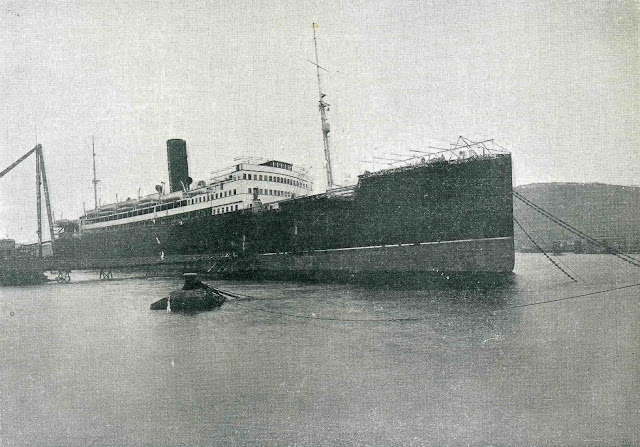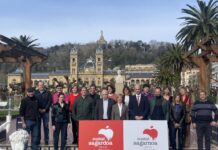We have written so much about the boys and girls who had to leave the Basque Country in 1937, bound for different parts of the world, to protect them from the disasters being wrought by Franco’s insurgents. We know them as the war children.
We think it is supremely important to recall these stories today, in this day and age, when our society, Basque society, has the moral obligation, or so we believe, to return part of the support and solidarity it received. We’ve commented on this on other occasions.
This topic was also referenced in Gregorio Arrien’s book ¡Salvad a los niños! Historia del exilio vasco en Gran Bretaña, 1937-1940, (Save the Children! The History of Basque Exile in Great Britain, 1937–1940), which the Sabino Arana Foundation has just republished, this time digitally.
This thorough, in-depth study helps us to understand the innumerable hardships and serious problems many of our children went through, as did all our refugees, in those years. They went through them, despite the fact that the Basque Government had organized an immense support network that began by taking in the refugees from the fall of Gipuzkoa and culminated in a vast network which took in exiles, first in France, and then in Latin America.
If that whole mess was so terrible for our own people, what must it be like for so many refugees who have to abandon their homes without any support or any aid?
We’ve talked a lot about those boys and girls who had to take refuge abroad, but we’ve focused much of our attention on a group of 3,861 boys and girls who left the Basque Country bound for the UK on May 21, 1937. This attention is undoubtedly due to the incredible work of the BCA’37 UK – The Association for the UK Basque Children.
They set sail from Santurtzi, bound for Southampton, where they arrived on May 23, accompanied by 95 teachers, 120 aids, and 15 priests, as well as two doctors, two nurses, and British PM Leah Manning, as well as the captain and crew of the steamship Habana.
A while back, we shared a video of the arrival of the Habana to England, archived at the Wessex Film and Sound Archive.
The Habana
The Habana was a 10,550-ton transatlantic steamship built at La Naval in Sestao by the Transatlántica Company. She was launched in 1920 with the name Alfonso XIII, but was changed to Habana at the dawn of the Second Republic. She was 146 m (479 ft) long, with a beam of 19 m (62 ft) and a depth of 9 m (30 ft). She was designed to carry 2,064 passengers and 245 crewmen (source: Háblame de barcos)


At the start of Franco’s insurrection, the ship made regular trips to the US by going Bilbao—Cuba–Mexico–New York, or on pleasure cruises from Bilbao to London, taking refugees out of Gipuzkoa; she also served as a hospital ship. Finally, from May to June 1937, she was made responsible for getting out 16,800 children from the part of the Basque Country that was still under the control of its legitimate government.
-
- May 6: 2,275 children sailed to La Pallice, La Rochelle, western France
- May 16: 2,185 children were taken to Pauillac (near Bordeaux)
- May 21: 3,861 children were taken to Southampton
- June 1: 2,318 children were taken to La Pallice
- June 6: 1,733 children were taken to La Pallice
- June 13: 4,500 children were taken to Paulliac, 1,610 of whom were then taken on to Leningrad
This information comes from the report El vapor ‘Habana’: el viaje desde Bilbao y la llegada a Gran Bretaña (The steamship ‘Habana’: the trip from Bilbao and its arrival at Great Britain) by Natalia Benjamin and Cliff Kirkpatrick and collected by the BCA’37 UK – The Association for the UK Basque Children.
For those interested in knowing the history of those young Basque refugees who went to Great Britain, we recommend diving into the BCA’37 UK‘s website. This association has carried out some amazing work, and continues to do priceless work to preserve and share this part of the history of our country. We do hope that their work will some day be given the recognition it deserves in our country.
Gregorio Arrien’s Research
We have written about Basque Passionist, historian, and patriot Gregorio Arrien on more than a few occasions; especially when he passed away in 2019. The BCA’37 UK Association reported his passing with great sadness.
In his work as a researcher (one of his many facets), his research of political exile, and mainly the evacuation of the children during the 1936–1939 Civil War stand out. His interest and his links to this part of our history led him to becoming one of the founders, and first president, of the Association of Evacuated Children of ’37, in 1986.
His investigations into these children’s stories was compiled into a series of books that culminated in ¡Salvad a los niños! Historia del exilio vasco en Gran Bretaña, 1937-1940, published by the Sabino Arana Foundation in 2014.
This work is quite thorough, weighing in at 902 pages, but it covers everything related to the exile of Basque children in the United Kingdom. To write it, he pored through a huge volume of documentation, much of it unpublished before then, which had come from the London delegation of the Basque Government, as well as other archives, libraries, and numerous oral testimonies from the people who lived through it.
Essential reading
The book narrates the war in the Basque Country, the evacuation, and life in the various camps and boarding schools, but it also tells the stories of those who went with them, the teachers and priests, as well as the history of the London delegation and of the other Basque exiles who ended up in Great Britain.
It does not shy away from telling the problems these Basques had to live through during their exile, full of needs, hardships, misunderstandings, and uncertainty.
Arrien does not hide or downplay these problems. There were a lot of them, some of them quite serious. First, there was the opposition of the British Catholic Church itself, or the “neutral sympathy” the British Government showed for the rebels. Lastly, there were the doubts, heartaches, friction, hardships, and difficulties that the children, housewives, priests, and other Basque refugees had to survive in those dark hours.
It was a time for heroes, in the realest sense of the word, a time for people to deal with the problems and get this project off the ground, thereby keeping thousands of Basque children out of harm’s way and far from the horrors of war.
Basque boys, girls, and adults even had to deal with the wretched logic some British people came up with, saying that returning the boys and girls to the Basque Country and making their presence, and suffering, visible there would help end the war sooner. This logic saw them as pawns in a political chess game where “the worse it is, the better” seems to be an idea we can’t fully get away from.
But they also felt the support, solidarity, and commitment of thousands of British citizens who worked hard to make things a little easier for young and old alike, during this time of sadness and separation.
This is the commitment to the Basques that we can symbolically say we noted with George L Steer when he told the world of the bombing of Guernica. It was the same commitment made evident by so many British people to help our small nation. This is the same commitment shown even today, which goes to prove that “good shines brighter when surrounded by the darkest evil.”
A book, reprinted
This book sold out quite quickly, given the interest it raised with both professionals in the world of academia and in those interested in this most basic part of our nation’s history, and in the relatives of the boys and girls who were evacuated to Great Britain in 1937.
The Sabino Arana Foundation has decided that, given that the demand for this book has not diminished, to make it available to everyone as an ebook on their página web. This is the foundation’s first ebook, and it’s priced at €15.


This book is a must-read, because it recounts such an essential part of our history, and because it helps us understand something important which is all too often forgotten. We mean that, with all the mistakes and misery that are inevitably a part of human nature, there was, during those dark years, a group of Basque who were committed to democracy, freedom, and their people, and who performed miracles to defend those most in need.
At a time when it was easy, and perhaps even understandable, to subscribe to the “save yourself” philosophy, they became the role model of how, even when war brings out the worst of the worst, it also brings out the best of the best. And all of them are a part of that group of the best.
We’ll leave you with the first thirty pages of the book, and the first pages of the list with the names of the boys and girls who made that trip from Santurtzi to Southampton.
The ebook can be purchased at the Sabino Arana Foundation’s website, here.
Last Updated on Dec 3, 2023 by About Basque Country






























